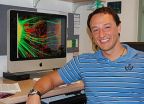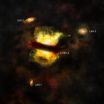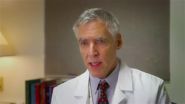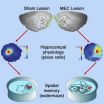(Press-News.org) With the help of mouse models, induced pluripotent stem cells (iPSCs) and the "tooth fairy," researchers at the University of California, San Diego School of Medicine have implicated a new gene in idiopathic or non-syndromic autism. The gene is associated with Rett syndrome, a syndromic form of autism, suggesting that different types of autism spectrum disorder (ASD) may share similar molecular pathways.
The findings are published in the Nov. 11, 2014 online issue of Molecular Psychiatry.
"I see this research as an example of what can be done for cases of non-syndromic autism, which lack a definitive group of identifying symptoms or characteristics," said principal investigator Alysson Muotri, PhD, associate professor in the UC San Diego departments of Pediatrics and Cellular and Molecular Medicine. "One can take advantage of genomics to map all mutant genes in the patient and then use their own iPSCs to measure the impact of these mutations in relevant cell types. Moreover, the study of brain cells derived from these iPSCs can reveal potential therapeutic drugs tailored to the individual. It is the rise of personalized medicine for mental/neurological disorders."
But to effectively exploit iPSCs as a diagnostic tool, Muotri said researchers "need to compare neurons derived from hundreds or thousands of other autistic individuals." Enter the "Tooth Fairy Project," in which parents are encouraged TO register for a "Fairy Tooth Kit," which involves sending researchers like Muotri a discarded baby tooth from their autistic child. Scientists extract dental pulp cells from the tooth and differentiate them into iPSC-derived neurons for study.
"There is an interesting story behind every single tooth that arrives in the lab," said Muotri.
The latest findings, in fact, are the result of Muotri's first tooth fairy donor. He and colleagues identified a de novo or new disruption in one of the two copies of the TRPC6 gene in iPSC-derived neurons of a non-syndromic autistic child. They confirmed with mouse models that mutations in TRPC6 resulted in altered neuronal development, morphology and function. They also noted that the damaging effects of reduced TRPC6 could be rectified with a treatment of hyperforin, a TRPC6-specific agonist that acts by stimulating the functional TRPC6 in neurons, suggesting a potential drug therapy for some ASD patients.
The researchers also found that MeCP2 levels affect TRPC6 expression. Mutations in the gene MeCP2, which encodes for a protein vital to the normal function of nerve cells, cause Rett syndrome, revealing common pathways among ASD.
"Taken together, these findings suggest that TRPC6 is a novel predisposing gene for ASD that may act in a multiple-hit model," Muotri said. "This is the first study to use iPSC-derived human neurons to model non-syndromic ASD and illustrate the potential of modeling genetically complex sporadic diseases using such cells."
INFORMATION:
For more information on the Tooth Fairy Project, visit http://muotri.ucsd.edu.
Co-authors include Karina Griesi-Oliveira, UCSD Department of Pediatrics, Rady Children's Hospital-San Diego and Universidade de Sao Paulo; Allan Acab, Thanathom Chailangkarn, Yanelli Nunez, Xiang Guoe and Gabriel Haddad, UCSD Department of Pediatrics and Rady Children's Hospital-San Diego; Abha R. Gupta, Yale University; Daniele Yumi Sunaga, Estavao Vadasz and Maria Rita Passos-Bueno, Universidade de Sao Paulo; Xavier Nicol and Nicholas Spitzer, UCSD Division of Biological Sciences and Kavli Institute for Brain and Mind; Michael F. Walker, John D. Murdoch, Stephan J. Sanders, Thomas V. Fernandez, Matthew W. State, Weizhen Ji and Richard P. Lifton, Yale University; Alexander Dietrich, Ludwig-Maximilians-Universitat Munchen; Dennis Pradhan, Hongjun Song and Guo-li Ming, Johns Hopkins University; and Maria C.N. Marchetto, Salk Institute for Biological Studies.
Funding support for this research came, in part, from the California Institute for Regenerative Medicine, the National Institutes of Health (grants 1-DP2-OD006495-01, T32 GM008666, NS047344, NS048271, HD069184, K08MH087639 and RC2MH089956), the Brain & Behavior Research Foundation, Fundacao de Amparo a Pesquisa do Estado de Sao Paulo and Conselho Nacional de Desenvolvimento Cientifico e Tecnologico.
Multiple models reveal new genetic links in autism
For answers, researchers turned to mice, stem cells and the 'tooth fairy'
2014-11-11
ELSE PRESS RELEASES FROM THIS DATE:
Breakthrough shows how the 'termites of the sea' digest wood
2014-11-11
An international research team led by Dan Distel, director of the Ocean Genome Legacy Center of New England Biolabs at Northeastern University, has discovered a novel digestive strategy in shipworms. The breakthrough, the researchers say, may also be a game-changer for the industrial production of clean biofuels.
To start, it's important to note that shipworms, the so-called "termites of the sea," aren't actually worms--they're bizarre clams that ...
Hospital workers wash hands less frequently toward end of shift, study finds
2014-11-11
WASHINGTON - Hospital workers who deal directly with patients wash their hands less frequently as their workday progresses, probably because the demands of the job deplete the mental reserves they need to follow rules, according to new research published by the American Psychological Association.
Researchers led by Hengchen Dai, a PhD candidate at the University of Pennsylvania, looked at three years of hand-washing data from 4,157 caregivers in 35 U.S. hospitals. They found that "hand-washing compliance rates" dropped by an average of 8.7 percentage points from the beginning ...
Too many people, not enough water: Now and 2,700 years ago
2014-11-10
The Assyrian Empire once dominated the ancient Near East. At the start of the 7th century BC, it was a mighty military machine and the largest empire the Old World had yet seen. But then, before the century was out, it had collapsed. Why? An international study now offers two new factors as possible contributors to the empire's sudden demise - overpopulation and drought.
Adam Schneider of the University of California, San Diego and Selim Adalı of Koç University in Istanbul, Turkey, have just published evidence for their novel claim.
"As far as we know, ...
Smoking associated with elevated risk of developing a second smoking-related cancer
2014-11-10
Results of a federally-funded pooled analysis of five prospective cohort studies indicate that cigarette smoking prior to the first diagnosis of lung (stage I), bladder, kidney or head and neck cancer increases risk of developing a second smoking-associated cancer. This is the largest study to date exploring risk of second cancers among current smokers.
An analysis of five large, prospective cohort studies indicates that lung (stage I), bladder, kidney and head and neck cancer survivors who smoked 20 or more cigarettes a day prior to their cancer diagnoses have an up ...
ALMA finds best evidence yet for galactic merger in distant protocluster
2014-11-10
Nestled among a triplet of young galaxies more than 12.5 billion light-years away is a cosmic powerhouse: a galaxy that is producing stars nearly 1,000 times faster than our own Milky Way. This energetic starburst galaxy, known as AzTEC-3, together with its gang of calmer galaxies may represent the best evidence yet that large galaxies grow from the merger of smaller ones in the early Universe, a process known as hierarchical merging.
An international team of astronomers observed these remarkable objects with the Atacama Large Millimeter/submillimeter Array (ALMA).
"The ...
Lung cancer screening with low-dose CT could be cost effective says Dartmouth study
2014-11-10
VIDEO:
Dartmouth researchers say lung cancer screening in the National Lung Screening Trial meets a commonly accepted standard for cost effectiveness as reported in the Nov. 6 issue of the New...
Click here for more information.
Dartmouth researchers say lung cancer screening in the National Lung Screening Trial (NLST) meets a commonly accepted standard for cost effectiveness as reported in the Nov. 6 issue of the New England Journal of Medicine. This relatively new screening ...
The brain's 'inner GPS' gets dismantled
2014-11-10
Imagine being able to recognize your car as your own but never being able to remember where you parked it. Researchers at University of California, San Diego School of Medicine have induced this all-too-common human experience - or a close version of it - permanently in rats and from what is observed perhaps derive clues about why strokes and Alzheimer's disease can destroy a person's sense of direction.
The findings are published online in the current issue of Cell Reports.
Grid cells and other specialized nerve cells in the brain, known as "place cells," comprise ...
The cat's meow: Genome reveals clues to domestication
2014-11-10
Cats and humans have shared the same households for at least 9,000 years, but we still know very little about how our feline friends became domesticated. An analysis of the cat genome by researchers at Washington University School of Medicine in St. Louis reveals some surprising clues.
The research appears Nov. 10 in the Proceedings of the National Academy of Sciences Early Edition.
Cats have a relatively recent history of domestication compared with dogs; canines arose from wolves over 30,000 years ago.
"Cats, unlike dogs, are really only semidomesticated," said ...
Study ties conflict risk in sub-Saharan Africa to climate change, economics, geography
2014-11-10
A massive new University of Colorado Boulder study indicates there is a statistical link between hotter temperatures generated by climate change and the risk of armed conflicts in sub-Saharan Africa.
CU-Boulder Professor John O'Loughlin led a research team that assessed more than 78,000 armed conflicts between 1980 and 2012 in the Sahel region of Africa - a semi-arid belt just south of the Saharan Desert that spans about 3,000 miles and more than a dozen countries from the Atlantic to the Indian oceans.
The team was looking for links between armed conflicts and temperature ...
ACA health insurance plans differ in cost, coverage and hospital access across Texas
2014-11-10
HOUSTON - (Nov. 10, 2014) - An analysis of more than 100 health insurance plans across Texas offered under the Affordable Care Act (ACA) shows that plans can differ significantly in premium cost and the number of hospitals included in insurance networks. That's just one of the findings of a report released today by the Episcopal Health Foundation and Rice University's Baker Institute for Public Policy.
The report examined "Silver" health insurance plans offered by insurers within the ACA's Marketplace. Texas is divided into 26 different geographic areas, with different ...
LAST 30 PRESS RELEASES:
Making lighter work of calculating fluid and heat flow
Normalizing blood sugar can halve heart attack risk
Lowering blood sugar cuts heart attack risk in people with prediabetes
Study links genetic variants to risk of blinding eye disease in premature infants
Non-opioid ‘pain sponge’ therapy halts cartilage degeneration and relieves chronic pain
AI can pick up cultural values by mimicking how kids learn
China’s ecological redlines offer fast track to 30 x 30 global conservation goal
Invisible indoor threats: emerging household contaminants and their growing risks to human health
Adding antibody treatment to chemo boosts outcomes for children with rare cancer
Germline pathogenic variants among women without a history of breast cancer
Tanning beds triple melanoma risk, potentially causing broad DNA damage
Unique bond identified as key to viral infection speed
Indoor tanning makes youthful skin much older on a genetic level
Mouse model sheds new light on the causes and potential solutions to human GI problems linked to muscular dystrophy
The Journal of Nuclear Medicine ahead-of-print tip sheet: December 12, 2025
Smarter tools for peering into the microscopic world
Applications open for funding to conduct research in the Kinsey Institute archives
Global measure underestimates the severity of food insecurity
Child survivors of critical illness are missing out on timely follow up care
Risk-based vs annual breast cancer screening / the WISDOM randomized clinical trial
University of Toronto launches Electric Vehicle Innovation Ontario to accelerate advanced EV technologies and build Canada’s innovation advantage
Early relapse predicts poor outcomes in aggressive blood cancer
American College of Lifestyle Medicine applauds two CMS models aligned with lifestyle medicine practice and reimbursement
Clinical trial finds cannabis use not a barrier to quitting nicotine vaping
Supplemental nutrition assistance program policies and food insecurity
Switching immune cells to “night mode” could limit damage after a heart attack, study suggests
URI-based Global RIghts Project report spotlights continued troubling trends in worldwide inhumane treatment
Neutrophils are less aggressive at night, explaining why nighttime heart attacks cause less damage than daytime events
Menopausal hormone therapy may not pose breast cancer risk for women with BRCA mutations
Mobile health tool may improve quality of life for adolescent and young adult breast cancer survivors
[Press-News.org] Multiple models reveal new genetic links in autismFor answers, researchers turned to mice, stem cells and the 'tooth fairy'




